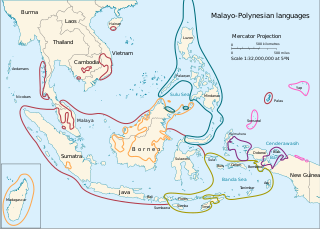Related Research Articles

The Malayo-Polynesian languages are a subgroup of the Austronesian languages, with approximately 385.5 million speakers. The Malayo-Polynesian languages are spoken by the Austronesian peoples outside of Taiwan, in the island nations of Southeast Asia and the Pacific Ocean, with a smaller number in continental Asia in the areas near the Malay Peninsula, with Cambodia, Vietnam and the Chinese island Hainan as the northwest geographic outlier. Malagasy, spoken on the island of Madagascar off the eastern coast of Africa in the Indian Ocean, is the furthest western outlier.

East Kalimantan is a province of Indonesia. Its territory comprises the eastern portion of Borneo/Kalimantan. It had a population of about 3.03 million at the 2010 census, 3.42 million at the 2015 census, and 3.766 million at the 2020 census; the official estimate as at mid 2023 was 4,030,488. Its capital is the city of Samarinda.

António Maria da Silva, GCTE was a Portuguese politician. An engineer, he was a prominent member of the Portuguese Republican Party. He was Prime Minister for four times, during the Portuguese First Republic. After his party's victory in the legislative elections of 8 November 1925, he was invited to form a government. He led a great campaign against President Manuel Teixeira Gomes, that forced him to resign. He was the last Prime Minister of the 1st Republic, resigning two days after the 28 May 1926 military movement.

Antonio das Mortes is a 1969 Brazilian western film directed by Glauber Rocha. It is often cited as the last installment of Rocha's film trilogy, preceded by Black God, White Devil and Entranced Earth. It features return of the character Antonio das Mortes, now as the protagonist, again played by Maurício do Valle. The original title is a reference to the tale of Saint George and the Dragon.

Berau Malay, or just Berau, is an Malayic language which is spoken by Berau Malays in Berau Regency, East Kalimantan, Indonesia. It is one three native Malayic varieties in southern and eastern Borneo along with Banjar and Kutai, of which it forms a dialect continuum.
The Ibanic languages are a branch of the Malayic languages indigenous to western Borneo. They are spoken by the Ibans and related groups in East Malaysia and the Indonesian province of West Kalimantan. Other Dayak languages, called Land Dayak, which are not Ibanic, are found in the northwest corner of Kalimantan, between Ibanic and non-Ibanic Malayic languages such as Kendayan and the Malay dialects of Sarawak and Pontianak.

Lun Bawang or Lundayeh is the language spoken by the Lun Bawangs. It belongs to the Malayo-Polynesian family.
The Kayanic or Kayan–Murik languages are a group of Austronesian languages spoken in Borneo by the Kayan, Morek Baram, Bahau, and related peoples.
The Barito languages are around twenty Austronesian languages of Indonesia (Borneo), plus Malagasy, the national language of Madagascar, and the Sama–Bajaw languages around the Sulu Archipelago. They are named after the Barito River located in South Kalimantan, Indonesia.
The Greater North Borneo languages are a proposed subgroup of the Austronesian language family. The subgroup historically covers languages that are spoken throughout much of Borneo and Sumatra, as well as parts of Java, and Mainland Southeast Asia. The Greater North Borneo hypothesis was first proposed by Robert Blust (2010) and further elaborated by Alexander Smith. The evidence presented for this proposal are solely lexical. Despite its name, this branch has been now widespread within the Maritime Southeast Asia region.
Maanyan or Maʼanyan is an Austronesian language belonging to the East Barito languages. It is spoken by about 150,000 Ma'anyan people living in the province of Central Kalimantan and South Kalimantan, Indonesia. It is most closely related to the Malagasy language spoken in Madagascar, although these languages are not mutually intelligible due to the geographical separation.

Pilão Arcado is a municipality in the state of Bahia in the North-East region of Brazil. Pilão Arcado covers 11,731.5 km2 (4,529.6 sq mi), and has a population of 35,175 with a population density of 3 inhabitants per square kilometer.
Punan language can refer to several Austronesian languages of Borneo:

Raphaël Adelino José Guerreiro is a professional footballer who plays as a left-back or midfielder for Bundesliga club Bayern Munich and the Portugal national team.
Saʼban is one of the remoter languages of Borneo, on the Sarawak–Kalimantan border. The language is known as hmeu Saʼban in the Saʼban language.
Umaʼ Lasan is a Kayan language of Borneo. Umaʼ Lung is marginally intelligible with the other varieties.
Segai, also known as Punan Kelai, is a Kayanic language spoken in several communities along the Kelai River, Berau Regency, East Kalimantan, Indonesia.
Merap (Mbraa) is an Austronesian language of Borneo in Indonesia. Soriente (2015) classifies Mbraa as a Kayan–Murik (Modang-Bahau) language.
Aoheng, or Penihing, is a Kayan language of East Kalimantan, Indonesia, one of several spoken by the Penan people.
The Lebbo' people are part of the indigenous Dayak people of East Kalimantan and North Kalimantan, Indonesia.
References
- ↑ Modang at Ethnologue (18th ed., 2015) (subscription required)